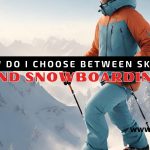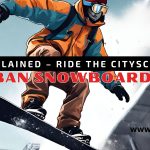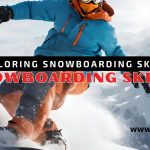Are you a snowboarding enthusiast looking to up your game on the slopes? Or perhaps you’re a curious adventurer seeking to understand the intricacies of this thrilling winter sport. Regardless of your experience level, one question surely comes to mind: what sets freeride and freestyle snowboarding apart?
In this article, we will explore the exciting world of snowboarding and delve into the distinctions between freeride and freestyle. We’ll discuss the unique features of each style, the types of tricks commonly associated with them, and help you understand which style might suit your preferences and goals on the mountain.
So, whether you’re in pursuit of gravity-defying jumps and flips or the freedom of exploring untouched slopes in the backcountry, read on as we unveil the captivating world of snowboarding freeride and freestyle.
Understanding Freeride Snowboarding

Freeride snowboarding is a thrilling style that allows riders to explore the untouched backcountry and carve their own path down the mountain. It is all about the pursuit of freedom and finding the perfect lines in the most natural and challenging environments.
When it comes to freeride snowboarding, the right equipment is crucial. Riders typically opt for a freeride snowboard, which is designed to handle varied terrain and provide stability at higher speeds. These boards are often longer, wider, and have a stiffer flex compared to those used in other disciplines.
Conquering the Backcountry
The backcountry is the playground of freeride snowboarding. With vast expanses of pristine snow, untouched powder fields, and majestic mountain vistas, it offers endless opportunities for exploration and adrenaline-fueled descents.
Freeride snowboarding in the backcountry comes with its own set of challenges and dangers. It requires knowledge of avalanche safety, navigation skills, and a deep understanding of the snowpack and weather conditions. Rider awareness and preparedness are essential for a safe and enjoyable experience.
In addition to the backcountry, freeride snowboarding can also be enjoyed on ungroomed slopes within resorts. These off-piste areas offer a taste of the backcountry experience but with the added convenience of resort amenities.
Freeride Events
Freeride snowboarding has gained popularity over the years, leading to the emergence of exciting freeride events around the world. These events celebrate the skills, creativity, and daring nature of freeride snowboarding.
One of the most prestigious freeride events is the Freeride World Tour, where the best riders from around the globe compete on legendary mountains for the title of world champion. This elite competition showcases the highest level of freeride snowboarding and captivates audiences with breathtaking performances.
In addition to the Freeride World Tour, there are numerous national and regional freeride events that provide a platform for up-and-coming riders to showcase their skills. These events not only foster a sense of community but also inspire the next generation of freeride snowboarders.
Exploring the Limits
Freeride snowboarding is all about pushing boundaries and seeking new challenges. Whether it’s dropping into a steep couloir, navigating through a dense forest, or launching off natural features, freeriders are constantly exploring the limits of what is possible on a snowboard.
While freeride snowboarding is driven by the desire for personal progression, it is also about appreciating and respecting the natural environment. Riders understand the importance of leaving no trace and preserving the pristine beauty of the backcountry for future generations to enjoy.
Next, we’ll dive into the dynamic world of freestyle snowboarding, where riders showcase their creativity and technical skills in terrain parks. Stay tuned!
Exploring Freestyle Snowboarding

Welcome to the exhilarating world of freestyle snowboarding! In this section, we will take a deep dive into the dynamic realm of freestyle snowboarding, where riders ignite their passion for the sport in terrain parks filled with exciting features and challenging obstacles.
Terrain parks are purpose-built areas that provide snowboarders with an array of specially designed elements to perform their tricks and maneuvers. These parks typically feature jumps, rails, boxes, and other creative structures that allow riders to showcase their creativity and technical skills. Whether you’re a beginner learning the basics or an experienced rider pushing the limits, terrain parks offer endless possibilities for excitement and progression.
Features Found in Terrain Parks
The heart of freestyle snowboarding lies within the fascinating features found in terrain parks. Let’s take a closer look at what riders can expect to encounter:
- Jumps: Launch yourself into the air with confidence and style. Jumps in terrain parks vary in size and difficulty, from small kickers for beginners to massive booters for seasoned pros.
- Rails: Test your balance and sliding skills on rails of various shapes and sizes. Grind, slide, and spin along these metal or wooden structures, adding an element of technicality to your riding.
- Boxes: Hone your control and creativity on boxes, which are similar to rails but offer a wider surface area. Slide, bonk, and butter your way across these fun obstacles.
- Halfpipes: These colossal U-shaped structures allow riders to catch massive air while executing mind-blowing tricks. Halfpipes are a staple in freestyle snowboarding and are often the centerpiece of major competitions and events.
The combination of these features creates an incredibly versatile and ever-evolving playground for freestyle snowboarders. It’s a hub of innovation and progression, where riders constantly push the boundaries of what’s possible on a snowboard.
Freestyle Snowboard Competitions
Freestyle snowboarding competitions provide riders with a platform to showcase their skills and creativity, captivating both participants and spectators alike. These events attract some of the most talented riders from around the globe, as they compete against each other for recognition and glory.
During freestyle snowboard competitions, riders perform a series of incredible tricks and maneuvers, aiming to impress the experienced judges who meticulously critique every aspect of their performance. Each trick is carefully evaluated, considering factors such as difficulty, execution, amplitude, style, and overall impression.
From stylish grabs and tweaked rotations to mind-bending spins and flips, these competitions showcase the evolution and innovation of freestyle snowboarding tricks. They provide a platform for athletes to break new ground and inspire others with their boundary-pushing moves.
| Freestyle Snowboard Competitions | Location | Date |
|---|---|---|
| X Games | Aspen, Colorado, USA | January |
| Burton US Open | Vail, Colorado, USA | February |
| World Snowboarding Championships | Vail, Colorado, USA | February |
| Olympic Winter Games | Various host cities | Every four years |
These competitions push the boundaries of what’s possible in freestyle snowboarding and provide a platform to inspire and motivate riders at all levels. Whether you’re a spectator marveling at the incredible tricks or a participant stepping up to the challenge, freestyle snowboard competitions truly embody the spirit of the sport.
Key Differences and Similarities

When it comes to snowboarding, two prominent styles emerge: freeride and freestyle. While both offer unique experiences on the mountain, they differ in terms of focus, techniques, and objectives. Understanding the distinctions between these two styles is essential for snowboarders looking to choose the right approach that aligns with their preferences and goals.
Differences:
- Focus: Freeride snowboarding is all about exploring the untouched backcountry and seeking out pristine powder. Riders venture off-piste, enjoying the thrill of discovering new lines on the mountain. In contrast, freestyle snowboarding takes place in terrain parks, where riders showcase their skills on various obstacles like jumps, rails, and boxes.
- Techniques: Freeride snowboarding requires specific techniques to navigate unpredictable terrains. Riders focus on adapting to changing conditions, using their body movements and equipment to conquer challenging slopes. On the other hand, freestyle snowboarding involves mastering technical tricks and maneuvers, combining balance, agility, and creativity to perform gravity-defying moves in the terrain park.
- Objectives: Freeride snowboarding emphasizes the freedom and adventure of exploring the mountain. Riders seek adrenaline-pumping descents, finding solace in the untouched beauty of remote locations. In contrast, freestyle snowboarding is centered around pushing the boundaries of what’s possible on a snowboard, constantly innovating and pushing the limits of creativity and skill.
Similarities:
While freeride and freestyle snowboarding have distinct characteristics, there are some shared elements between the two styles:
- Passion: Both styles require a deep passion for snowboarding, as riders immerse themselves in the sport, honing their skills and pushing their limits.
- Physicality: Both freeride and freestyle snowboarding demand physical fitness and agility. Riders need strength, balance, and coordination to excel in their chosen style.
- Creative Expression: Whether it’s finding the perfect line in the backcountry or inventing new tricks in the terrain park, both styles offer opportunities for riders to express their creativity and individuality on the mountain.
By understanding the key differences and similarities between freeride and freestyle snowboarding, riders can make informed choices based on their preferences and goals. Each style provides a unique and exhilarating experience, offering endless possibilities for snowboarders to carve their own path on the slopes.
| Freeride Snowboarding | Freestyle Snowboarding |
|---|---|
| Focuses on exploring the backcountry and finding untouched terrain | Takes place in terrain parks with various obstacles like jumps, rails, and boxes |
| Techniques involve adapting to changing conditions and conquering challenging slopes | Requires mastery of technical tricks and maneuvers, combining balance and creativity |
| Objective is the thrill of discovering new lines and enjoying the freedom of riding untouched powder | Objective is to push the boundaries of what’s possible on a snowboard, constantly innovating and performing gravity-defying moves |
Tips for Transitioning Between Styles
Transitioning between freeride and freestyle snowboarding can be an exhilarating but challenging experience. It requires a shift in technique, mindset, and even equipment. Here are some valuable tips and advice to ensure a smooth transition and enhance your overall snowboarding experience.
1. Understand the Differences
Before diving into a new snowboarding style, it’s crucial to have a solid understanding of the differences between freeride and freestyle. While both styles involve snowboarding, they have distinct focuses and objectives.
Freeride is all about exploring untouched backcountry terrain, riding off-piste, and finding the perfect lines on the mountain. It requires strong overall riding skills and the ability to adapt to varying snow conditions.
Freestyle snowboarding, on the other hand, takes place in terrain parks. It involves performing tricks and jumps on specially designed features like jumps, rails, and boxes. It requires technical precision, creativity, and a willingness to push your limits.
2. Adjust Your Technique
Successfully transitioning between freeride and freestyle also requires adjustments in technique.
For freeride: Focus on building stability and control, as you’ll be riding in unpredictable natural environments. Work on mastering carving turns and adjusting your weight distribution to handle different snow conditions.
For freestyle: Develop your aerial awareness and balance. Practice jumps and spins on smaller features before progressing to larger jumps. Work on your timing and landing technique to ensure you execute tricks safely.
3. Adapt Your Mindset
Transitioning between snowboarding styles also involves adopting a new mindset.
For freeride: Embrace the sense of adventure and exploration. Be prepared for unexpected terrain and weather conditions. Stay focused and make decisions based on your experience and knowledge of the mountain.
For freestyle: Cultivate a mindset of creativity and progression. Embrace the learning process and be willing to try new tricks and techniques. Embrace the challenge of perfecting your skills on different features in the terrain park.
4. Equip Yourself Appropriately
Having the right equipment is essential for a smooth transition between freeride and freestyle snowboarding.
For freeride: Opt for a freeride snowboard that provides stability and control in a variety of conditions. Consider choosing bindings that offer maximum support and flexibility for off-piste riding.
For freestyle: Look for a freestyle-specific snowboard that is lighter and more maneuverable. Choose bindings that allow for quick and dynamic movements, enhancing your ability to perform tricks in the terrain park.
Remember to always wear appropriate protective gear, such as a helmet and impact-resistant clothing, regardless of the snowboarding style you choose.
By following these tips and making the necessary adjustments, you’ll be well-equipped to transition smoothly between freeride and freestyle snowboarding. Embrace the unique challenges and joys of each style, and enjoy pushing your boundaries in the world of snowboarding.
| Freeride Snowboarding | Freestyle Snowboarding |
|---|---|
| Riding off-piste in backcountry terrain | Performing tricks in terrain parks |
| Emphasizes exploration and finding the perfect line | Showcases creativity and technical skills |
| Requires stability and adaptability in varying snow conditions | Demands aerial awareness and precise technique |
Conclusion
After exploring the differences and nuances between snowboarding freeride and freestyle, it’s clear that both styles offer unique experiences for riders on the mountain.
Freeride snowboarding takes adventurers into the untouched backcountry, challenging them with rugged terrain and providing opportunities for exhilarating descents. With a focus on exploring and finding the perfect lines, freeride offers an awe-inspiring connection with nature.
On the other hand, freestyle snowboarding showcases the creativity and technical skills of riders in terrain parks. With jumps, rails, and boxes, riders can push their limits and perform impressive tricks that captivate audiences and fellow riders alike.
Whether you prefer the adrenaline rush of conquering the backcountry or perfecting your skills in the terrain park, snowboarding offers endless excitement and opportunities for riders to push their limits and find their own style. So grab your snowboard, head to the mountains, and enjoy the thrill of freeride or the artistry of freestyle—it’s all about the love for snowboarding and the freedom it brings.
FAQ
Q: What’s the difference between snowboarding freeride and freestyle?
A: Snowboarding freeride and freestyle are two distinct styles with their own unique characteristics. Freeride snowboarding focuses on exploring the untouched backcountry, finding pristine lines, and riding in challenging natural environments. On the other hand, freestyle snowboarding is all about showcasing technical skills and creativity in terrain parks, where riders perform tricks on features like jumps, rails, and boxes.
Q: What types of tricks are commonly associated with freestyle snowboarding?
A: Freestyle snowboarding allows riders to showcase an array of tricks and maneuvers. Some common tricks performed in terrain parks include grabs, spins, flips, and slides. Riders can get creative and combine these tricks to create unique and stylish performances in competitions and while riding with friends.
Q: What is the equipment typically used for freeride snowboarding?
A: Freeride snowboarding typically involves using specialized equipment designed to handle various off-piste conditions. This includes a wider, more directional snowboard with a stiffer flex, which provides stability and control while riding in deep snow and variable terrain. Additionally, freeride snowboarders often use splitboards, which can split into skis for ascending uphill and then merge back into a snowboard for descending. Other essential equipment includes avalanche safety gear, such as a transceiver, shovel, and probe.
Q: What are some popular freeride events in snowboarding?
A: In the world of freeride snowboarding, there are several exciting events that showcase the skills and prowess of riders in challenging natural environments. The Freeride World Tour (FWT) is a renowned competition series where riders compete in locations around the globe, including iconic mountains like Verbier and Hakuba. These events allow riders to demonstrate their technical prowess, creativity, and ability to navigate steep and demanding terrain.
Q: How do freestyle snowboard competitions work?
A: Freestyle snowboard competitions are judged events where riders perform tricks and maneuvers in terrain parks to earn points. Judges assess the difficulty, execution, style, and overall performance of each rider’s runs. Competitions can feature different formats, including slopestyle, halfpipe, and big air. Each format has its own specific set of features and judging criteria. These events provide a platform for riders to showcase their skills, creativity, and innovation in the freestyle discipline.
Q: What are the key differences and similarities between freeride and freestyle snowboarding?
A: While both freeride and freestyle snowboarding fall under the broader category of snowboarding, they have distinct differences. Freeride snowboarding focuses on exploring the untouched backcountry, while freestyle snowboarding takes place in terrain parks. Freeride emphasizes riding in natural environments, while freestyle highlights performing tricks and maneuvers on features like jumps and rails. However, both styles share a passion for shredding the slopes and pushing the limits of what’s possible on a snowboard.
Q: What tips can you offer for transitioning between freeride and freestyle snowboarding?
A: Transitioning between freeride and freestyle snowboarding can be challenging, but with the right approach, it’s certainly achievable. Here are a few tips to help make the transition smoother: 1. Familiarize yourself with the different terrain and features in terrain parks. 2. Practice the tricks and maneuvers commonly performed in freestyle snowboarding. 3. Adjust your mindset and approach, as the objectives of freeride and freestyle can differ. 4. Consider investing in the appropriate equipment for each style, such as a wider board for freeride and a board designed for park riding for freestyle. 5. Take lessons or seek guidance from experienced riders who are proficient in both styles. Remember, transitioning takes time and practice, so be patient with yourself and enjoy the journey.







